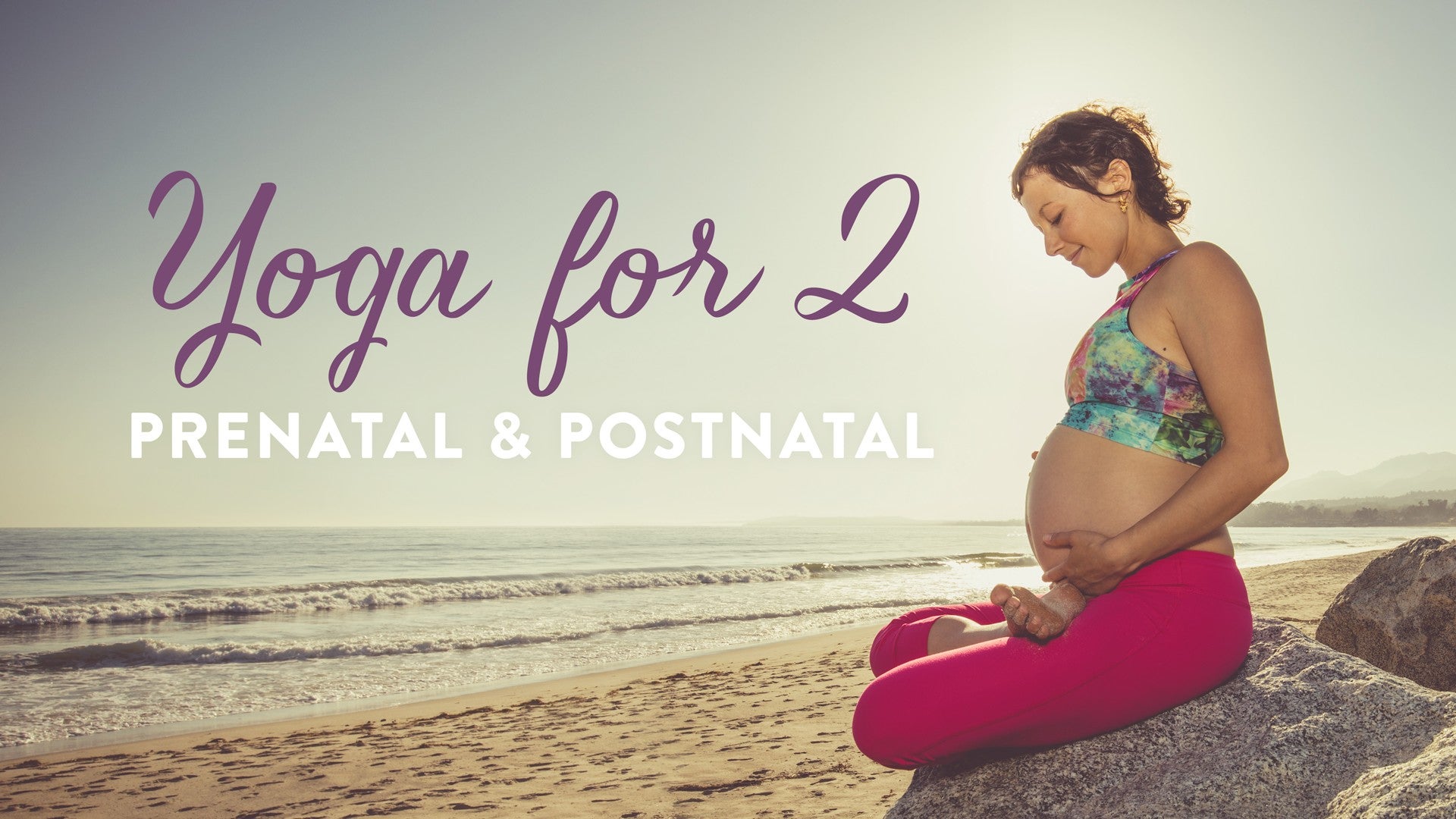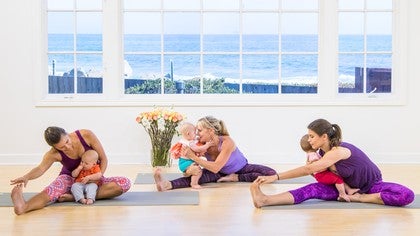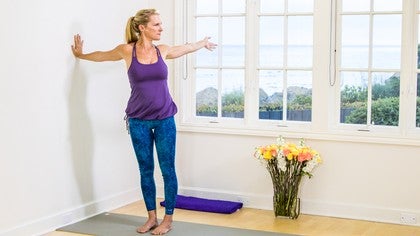Description
About This Video
Transcript
Read Full Transcript
(waves gently breaking) Hi. So we're gonna do a little bit of a practice that speaks to some of the discomforts of the shoulders and the wrists that tend to happen from rounding the back so much and carrying all the equipment we're having to carry around, and also just creating a sense of opening and strength. We're gonna work up to doing... Some mamas get a lot of tension in the wrists and a lot of stiffness in the shoulders from breastfeeding or from bottle feeding. And so I'm gonna show you some things that you can do to start to strengthen and open those areas.
And then we'll work a little bit on the spine. So we're going to be using the wall. We will start standing and just use the wall a little bit and work down to seated, so you may need to have a little blanket to sit on if you like to sit down on something cushiony, but you just wanna be pretty close to the wall so that you can use it for support. So let's get started. Just warming up the shoulders, doing a couple big breaths and reaching.
So inhaling, just lengthening through the spine, reaching towards, fingertips together. Exhaling, opening. And let's do that again. Just breathing into those areas that may feel a little bit stiff and tense. And exhale.
So this time we'll just hold our arms up above our shoulders, and we'll just soften the shoulders and roll them down the back a little bit. And we're gonna be careful not to go into this arch and the cervical spine here, just by engaging our upper abs slightly and engaging our lower belly a little bit as we reach through the fingertips. Then we'll interlace them. Try to remember which pinky you have in front, whether it's the right or the left, and then just rotate your wrists and reach your palms up to the sky. So getting a little stretch through the hands.
Just be really soft and gentle. If you need to bend your elbows, feel free. Press through, just releasing the tension in the hands a little bit as you breathe. Good, and just roll the shoulders. Play around with rolling the shoulders down the back so you can lengthen out the neck.
And again notice if you're starting to do this, it tends to put a little tension in the neck and the lumbar spine, so we really wanna support the entire spine and neck. So we do that with a tiny bit of an engagement in the abdominal muscles. Good. So I have my right finger in front, pinky finger in front. I'm gonna release.
Maybe just rotate the wrists a little bit, so getting that sense of softness in the wrists. Still breathing nice and deep. Then float the arms back down. Good. Then we'll inhale.
Reach nice and long through the arms, through the elbows, energy through the fingers, and then start to float the shoulder blades down the back. And again noticing if you're arching in the upper spine or the lower spine, disengage a little bit in the abs as you open the shoulders and then bring whichever pinky you had in back last time, in front this time. And then start to rotate the wrists being really soft and gentle on them. You might bend the elbows a little bit, opening through the hands. If you're suffering from carpal tunnel syndrome, which is really common, then if you're getting that numbness, you may just really bend those elbows and just get a really gentle opening.
And if that's feeling really good to you, you can just start to press through a little bit more, getting a little more energy through the palms. So a couple more breaths. Checking in with your abs, checking in with your lower belly, that diaphragm area, and then just start to gently untangle the fingers and rotate the wrists around. Nice, soft little rotations. Like there's a nice breeze blowing through your hands.
And just start to float them open. So now we'll just work with the wall, doing a little bit more shoulder opening. So we'll come to the wall, stepping back far enough where you can straighten out your arms for now. And just opening those fingers, getting a little life in there. And connecting through the finger pads.
If you let go and you start to dip through the back, that's okay; you're opening through the armpits. But feel the difference if you start to lift and broaden through the shoulders and connect the tip of the tailbone with the crown of the head. Start to engage the lower belly a little bit. So you're supporting your spine with the muscles of your abdomen. And then draw the shoulder blades down the back so you can lengthen out your neck.
Should feel a little lengthening in your neck. Notice if your face is holding tension, so we can just breathe and soften it. Again, just release in a little bit of a dip here. So you're just getting a little soft opening in the armpits. And then start to come back up into those big broad shoulders.
Engaging the belly. Lengthen out the neck by drawing the shoulder blades down the back and shoulders away from the ears. Keeping a little bit of pressure between the hands and the wall. Just pausing for another breath, feeling that opening happening. Now we're gonna bend our knees a little bit.
Getting a little stretch in the Achilles. You're gonna tuck your tailbone a lot and release the crown of the head. And then just sort of roll out of it as you straighten the knees. Good, it's kind of like you're coming into like a down dog position, but you have the wall as support, so there's not as much pressure on your wrists. And you can see if this works for you, bending your elbows and kinda shooting down towards the earth, as opposed to out here.
And then broadening through the shoulders again so you get that sense of length in the neck. And if you need to bend the knees you can feel free to do that. We're just building up a little bit of strength in the arms, in the core without having too much pressure on the wrists like you might in chaturanga. Press through the hand and straighten them out. Play around with that.
If you wanna walk the hands up and get a little softer angle on the wrists, you can do that. Just bending, feeling the base of the finger pads connect to the wall. So we're just building up the strength, broadening the shoulders. And then let's sink back into our supported. Like a down dog, walk the hands down a little bit so they're in alignment with your sits bones.
Good, and then broaden your shoulders. Shoulder blades come down the back to lengthen out your neck. It's very subtle. Engage the lower belly. Bend the knees.
And then we're gonna roll up again. So we're gonna tuck the tailbone, release the crown of the head, and start to get that sensation of that spine uncoiling as you come closer to the wall. Walk the hands up and soften the angle a tad. Just bend the elbows a bit, getting that strength there, broadening through the shoulders, connecting through the hands in the wall, breathing. Notice what your face is doing. (chuckles) Soften it up if it's getting tense.
Good, press on out. Good, might feel good this time. Let's just pause here. Take a breath. On your exhale, just start to walk your feet a little closer into the wall, towards the wall.
Good, now we'll just get a little bit of an opening by bringing in our wrist in alignment with our shoulder. Spread through those fingers. Feet are about hip-distance apart. They can be closer or farther if that feels better for you. And we're gonna just open this opposite arm as we stay connected to the wall.
Just getting a nice shoulder opener there. Good, and then maybe coming back. This time maybe making a little bit bigger. Expanding through the front of the chest. And one more time.
And just coming back into this neutral position. Now we're gonna bring our feet a little closer together. We're gonna sway the hips away from the wall. Feel free to bend the elbow a little bit, that's connected to the wall. Take this arm up.
Just expand. So it's like you're doing a side plank and you're getting all the benefits of the side plank but without having that weight happening on the wrist or the shoulder. Good, and then just come on out of it nice and slow. And then we'll just give the other arm an opportunity to get the nice shoulder opening there. So arm extends right out from the shoulder.
Wrist is in alignment with the shoulder. See if you can spread through those fingertips. Good, getting a little energy through the hand. Feet more or less hip-width apart. And then just start to open and spiral out.
Opening as much as comfortable for you and then bringing it back in on an inhale. And then back out, nice spiral happening. Shoulder opening, tiny bit of a twist. And again, one last time. You might get a little bigger range of motion this last time.
Just to a point where it feels really good. Good, and then we'll stay where we are but bring our feet a little closer together and then just sway the hips away from the wall a bit. Take this arm, reach it around. Go into your side plank on the wall. Stretching, opening, spiraling that rib cage open, open through the shoulder, down the back.
Good. And then just coming back around and back open. So now we're gonna bring our hands back to the wall. We're just gonna walk our booties out a bit. And we're gonna feel the connection between, we're gonna try to feel the connection between the shoulder opening and a little bit of balance.
So in other words, I want you to think about how your core kind of supports the opening that can happen in your shoulders, and the squaring of your hips helps you keep your shoulders square. It's kind of like a Warrior III supported. And then just connect and push back into the wall a little bit, using the wall to support you. So there's all these different things happening that help keep strain out of one area of the body. And instead we're just distributing the stretch and the strength throughout the body.
Engaging the lower belly to support the lower spine. Pressing through the hands. Squaring through the hips and the shoulders equally. Good, lining up the crown of the head with the tailbone. On the next exhalation, just come right on back to standing and walk back towards the wall.
And let's just do a little stretch here for our quad, just supported here with the wall. This is just helping you with balance, and you can play around. I would encourage you to just do this without the wall, then come back to it when you feel like need the support. Just getting a little stretch. A little stretch in the hip flexor, and at the same time, what you can do is just roll the shoulder back a little and get a little opening.
You can even start to tilt forward and lift the toes up a little if that feels right for you, if your shoulders feel ready. You can play with the rotation of the wrist, holding your foot here, opening a little more. Engaging your lower belly. Drawing the shoulders down and away from your ears. Good.
Then just noticing that you have the support of the wall when you need it. Now let's just take it to the other side. So we're just taking this ankle here in the palm of the hand, getting that nice stretch. Just playing around with balance. If you'd like to, you can roll the shoulder open and start to tilt forward if that feels good.
Play around with the wrist, maybe taking it to the inner arch of the foot. If that feels good for you. Lower belly's engaging, supporting your spine. Your spine's kind of allowing that opening to happen in the shoulders. Then we're just coming back to standing, wherever you are.
Maybe you stayed in standing the whole time. It's okay. Then just releasing it down. And we didn't do our Warrior III, so let's do that. So we'll come out, making that T shape here, using the wall as support.
Just lift that, same way that you just worked a little bit. Square the hips. Engage the lower belly. Press through the hands. See if you can notice the connection between the heel of the lifted foot and the crown of the head.
And just walk it up or down if you need to adjust. Soften the face and the jaw. Couple breaths. Then as you're ready, just start to float that foot down. Good, so those are some ways that you can use the wall to help with your opening of the shoulder, building strength to work up to chaturanga, or if you're not feeling chaturanga one day and you just wanna use the wall or if you don't have time for a full practice, doing some of these things up against the wall can be really helpful for opening the shoulders, creating ease in the spine.
So now we'll a couple of things on the floor. So if you have your blanket nearby, or if you don't need one, then that's fine too, but just come into seated position. And we're gonna do a couple of shoulder openers with a twist. So, very gentle twist. We'll start in easy pose.
Lengthening through the spine, grounding through the hips, resting the shoulders. So notice which leg you have in front, and just take the opposite arm and reach it across towards that knee. And then you're gonna take this arm and reach it behind you. Sometimes you might need a block to rest it on there. Just get a little twist.
So you're lengthening the spine, and then gently twisting. So you might think of the inhale lengthening and the exhale allowing a little bit of a release to happen. Last couple of breaths here. Inhale, you might just ease up slightly, and then exhale, twist a little bit more if it feels right. Good, and just come back to the front, to a nice, neutral position here.
And you're gonna switch the cross of your legs. We'll do a little shoulder opener with the twist to the other direction, so just taking the leg that's in front. You're gonna take the opposite arm, reach it across, and then just take this back arm, set it on a block if that's what feels good for you, that's totally fine, otherwise on the floor behind you. Lengthen through the spine. Just a very gentle twist in the beginning.
So inhale. Exhale. Maybe starting to look over towards that shoulder, remembering not to let those shoulders creep up to the ears, just keeping them nice and long. Sometimes it helps to just visualize the spine like a vine wrapping around a tree or something that inspires your twist. Allowing the breath to really help ease you into the twist.
So sometimes just coming back out of it a little, easing out, and then going back in. Just a couple more breaths. See if you can get that sense of opening in the back shoulder happening. Good, and we'll just start to, on the exhale, come right back into a neutral spine. Good, so we're gonna transition now.
Maybe just take a little breath to feel how your shoulders and wrists feel, if they're feeling open, good, soft, just enjoy that for a moment. We'll just come seated here, bringing this blanket between our heels and our sits bones, if that's necessary. And then if you don't need it, you can just remove it. Set it aside. We're gonna do a couple more shoulder openers.
So we're gonna check in with our bellies first, feel the connection of the navel with the spine again, supporting your lumbar spine, helping it lengthen. Good, so we're gonna keep the arch. This is a really common thing to happen, to start arching, so we're just gonna keep it out by drawing the navel in slightly without contracting here. So there's a lot going on, just right here in this very simple posture. So it's a little lift in the sternum.
So reaching one arm up. Feel that length in the arm, and then just notice where your shoulder is. If it's creeping up by the ear, just draw it back and down a little bit. Draw the navel in towards the spine to support your lumbar spine. Start to bend it, and then reach the other arm, fingertips towards each other.
It's okay if they don't touch. Just reaching, getting that stretch, opening happening in the shoulders. Couple of breaths here. It's okay if the natural arch is happening, but we're gonna keep that deep arch out of the spine just so we can get the stretch happening mostly in the shoulders. Beautiful, and then open, and we'll just go directly to the other side.
So reaching up here, noticing the relationship between your top shoulder and your ear. If it's creeping up, let it draw down in a way creating length for the neck, and then start to bend both arms, fingertips reaching towards each other. May or may not touch. Just getting a nice opening happening in the back, and I can already feel my back just kind of wanting to go into this arch, so I'm drawing my navel in towards the spine and gently resting my head into my forearm, and then I'm opening through the bottom shoulder. And I'm breathing.
Couple more breaths, feeling open and expansive in those shoulders. Good, and the next exhalation, let's just soften, open. Good, and maybe just shaking the fingertips out, releasing any tension that might have accumulated. Rolling the shoulders, letting them be soft. So we're just gonna come into a child's pose.
So we'll be here, and then we'll just walk those fingertips way out and away from the body. Rest the belly on the thighs. Just notice where your elbows fall. Maybe take them in a little bit from the shoulders for this, if that feels okay for you. If not, you can have them open.
And then just rest the forehead down. Soften everything up, front of the throat, jaw, belly. Bring the palms together. And then start to walk the elbows a little bit closer together and a little bit further from the knees. And if that feels like you're getting enough of a stretch in the triceps and the deltoids and the shoulders, then you can just relax it there.
Otherwise, you can start to bend your elbows, palms together. Good. Pointing up towards the sky with your fingertips. Getting a nice little stretch in the shoulders, the trapezius muscles. Couple more breaths.
Breathing into those areas where we hold on to tension. In the next exhalation, just release the palms down. Let's just drag it up, leading with the middle of the back, keeping the fingertips on the earth for as long as possible, coming back until our sits bones are resting on our heels. So just getting a nice little stretch in the neck. Really soft through the hands.
And tall, you come back up to a nice, straight spine. And then, if you need your blanket for this, you may want to double it up or triple it up or just stay where you are. So you're just gonna do a little bit of a shoulder opener by walking the hands back slightly behind you. Fingertips can be in whatever direction feels right for you. So they can be back here or right here.
Just want it to feel good. And then could bend your elbows a little to take any tension out of the wrists. Just roll the shoulders open. Kind of lift your sternum a little bit. And if you wanna press your arms straight, you can do that, if it feels good your wrists.
And if it feels really good, you can release your head back, getting a little stretch in your neck. When it feels really, really good, (chuckles) you can just lift your pelvis up. We're going for really good, really, really good. So do what feels really, really good. Rest it back down.
Lift through the sternum, and just come back up. Good, and we'll just kind of soften and soften the fingers and find your way back into easy pose. Maybe you're gonna use your blanket to support your sacrum. And we'll just close our practice, our shoulder-opening, wrist-softening tender love and care for our backs, our spines, shoulders, neck, and wrists with our eyes closed. Just taking a couple of breaths into those areas that we just touched with the movement.
Inhaling through the nose. Exhaling through the nose. Letting the shoulders rest a little bit, soften down towards the earth. And fingertips soft, wrists soft. Shoulders open.
Spine supple. We'll just bring our hands together and our hearts. And namaste. Thank you.
Yoga for 2: Prenatal and Postnatal: Postnatal
Comments

You need to be a subscriber to post a comment.
Please Log In or Create an Account to start your free trial.







